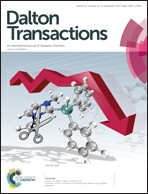Highly efficient degradation of dye pollutants by Ce-doped MoO3 catalyst at room temperature†
Abstract
In order to efficiently degrade organic pollutants via an easily operated method, Ce-doped MoO3 (Ce(x)/MoO3) samples are synthesized by a simple impregnation method. The samples are characterized by scanning electron microscopy (SEM), X-ray diffraction (XRD), high-resolution transmission electron microscopy (HRTEM), selected area electron diffraction (SAED), nitrogen sorption isotherms and UV-vis diffused reflectance spectra (UV-DRS), total organic carbon (TOC), infrared spectroscopy (IR) and mass spectrometry (MS) analyses. Furthermore, we have mainly investigated the degradation of different dye pollutants by the Ce(x)/MoO3 samples, including cationic methylene blue (MB), anionic methyl orange (MO), neutral phenol, and a MB–MO mixture dye. For the single-component MB and MO dyes, the highest degradation efficiencies are achieved by Ce(5)/MoO3 and Ce(10)/MoO3 samples. For the MB–MO mixture dyes, the highest degradation efficiency for MB is achieved by a Ce(10)/MoO3 sample. It is surprising that the degradation efficiency of MB in the MB–MO mixture dye solution is higher than that in the single-component MB dye solution, which has been mainly ascribed to the promoting effect of MO. Moreover, a plausible degradation mechanism of the dyes has been proposed and discussed. It should be noted that the degradation reaction is carried out at room temperature and normal atmospheric pressure, and without light irradiation. As a result, this degradation reaction is obviously different from the conventional thermally activated heterogeneous catalysis (or photocatalysis), in which thermal energy (or light irradiation) is indispensable; also different from a sorption technology, in which the pollutants cannot be degraded, but only transformed from one phase to another one. Thus, the reported degradation reaction is a quite promising environmental cleaning technology, which could be widely practically applied.


 Please wait while we load your content...
Please wait while we load your content...